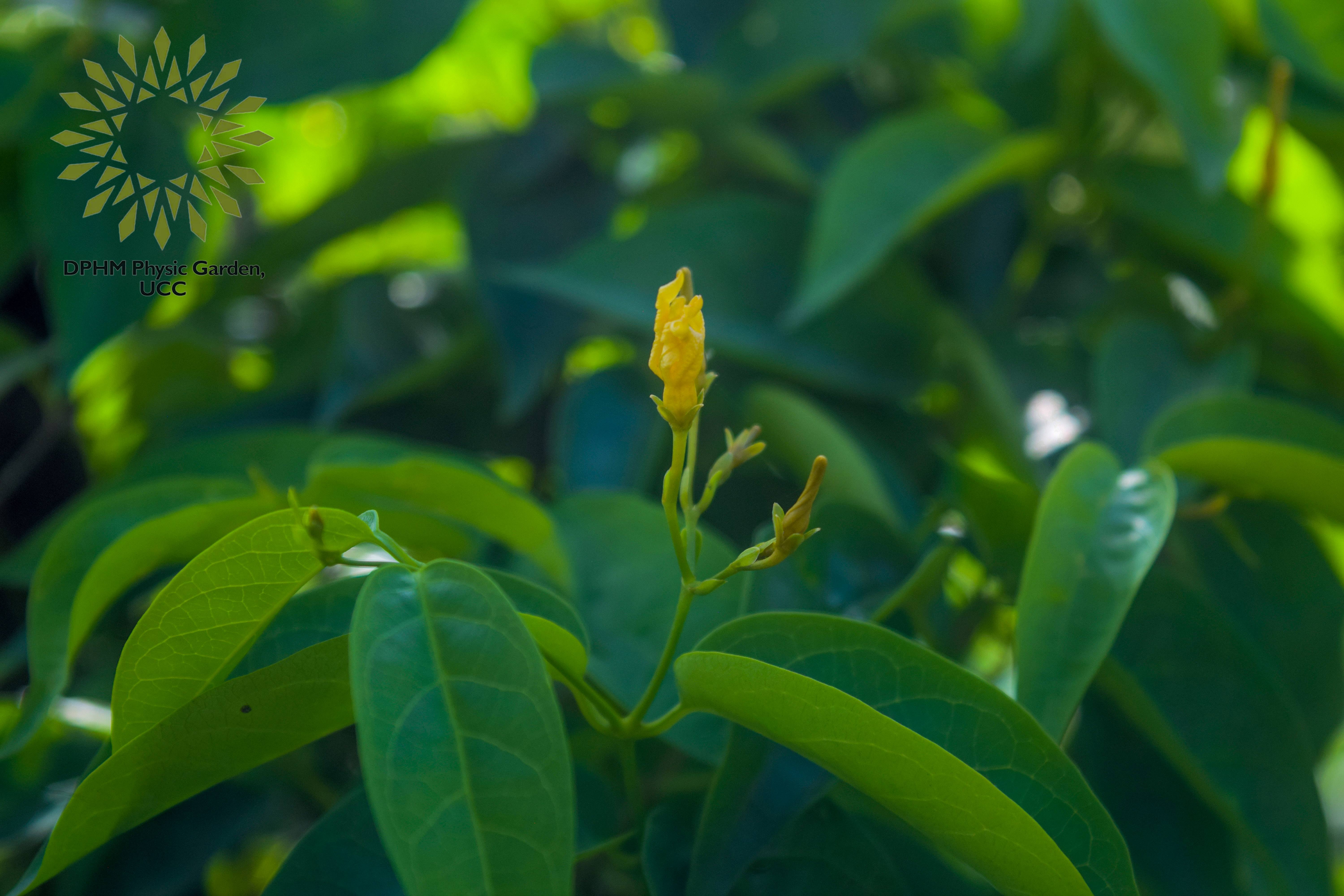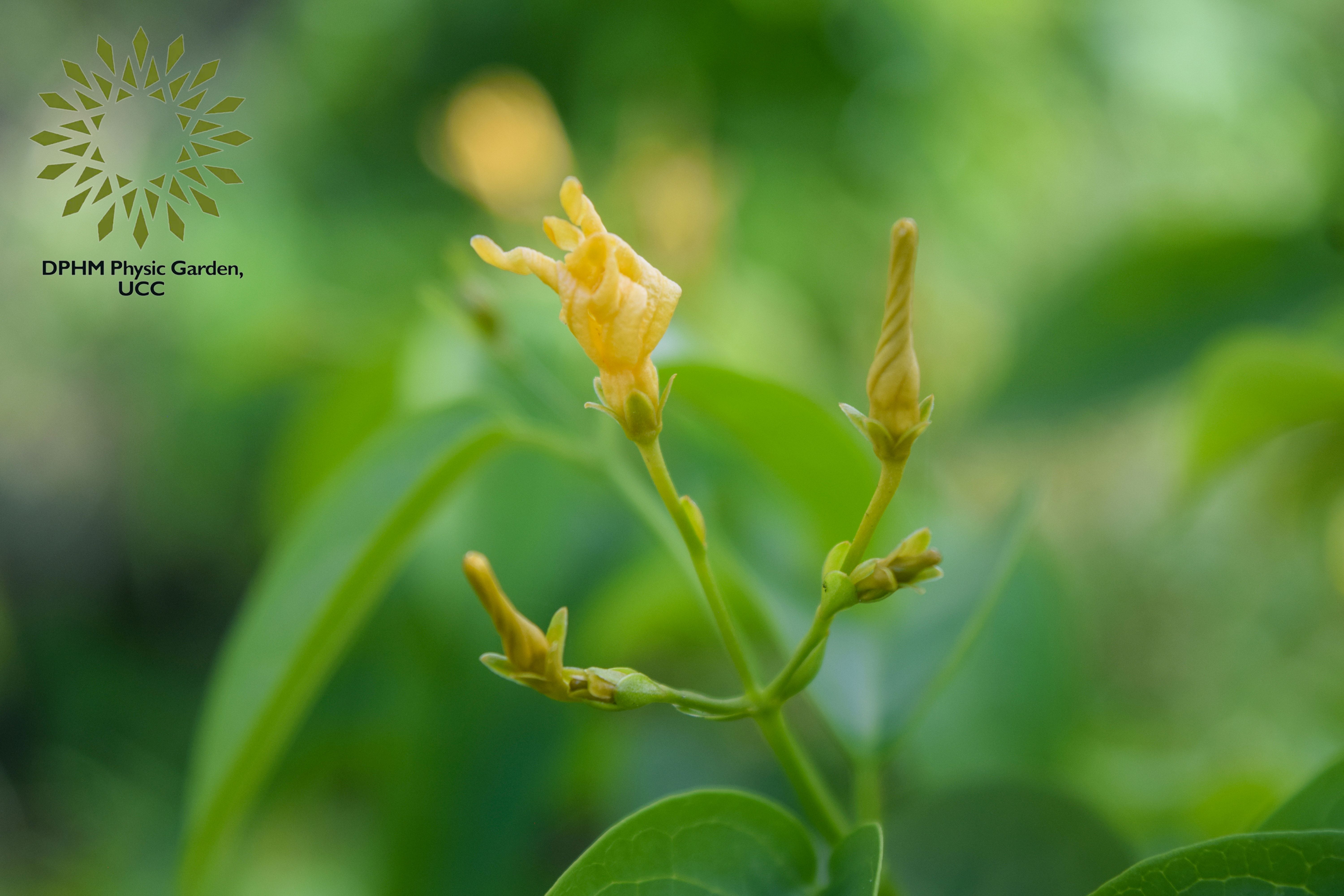CRYPTOLEPIS SANGUINOLENTA
TAXONOMY
Family: Apocynaceae Order: Gentianales Genus: Cryptolepis Species: C. sanguinolenta
Local name
Nibima(Twi), Kadze(Ewe), Gangnamau(hausa), Nurubima( Guans).
BOTANICAL DESCRIPTION
Cryptolepis sanguinolenta is a slender, scrambling shrub native to Africa, characterized by its twining stems and opposite, simple leaves that can grow up to 7 cm long and 3 cm wide. The plant exudes a yellowish latex that turns red when exposed, and it features few-flowered cymes with greenish-yellow flowers that are bisexual and regular, measuring about 1.5 cm long. The fruits are horn-like, paired in linear follicles, containing tiny, pinkish seeds encased in silky hairs. The roots, which can range from 0.4 to 6.6 cm in length, have a bitter flavor and a yellowish-brown color with longitudinal ridges when dried. This plant is traditionally used in West Africa for treating various ailments, including malaria and respiratory conditions.
ETHNOBOTANICAL USES
The plant is used in the treatment of malaria, diarrhea, and respiratory conditions.
PHYTOCHEMICAL COMPOSITION
Cryptoquindoline, cryptoheptine, biscryptolepine, 11-hydroxycryptolepine, quindolinone, isocryptolepine (Cryptosanguinolentine), neocryptolepine, quindoline, cryptolepine and cryptospirolepines are among the structurally similar alkaloids identified in the plant. Many indoloquinoline alkaloids, such as cryptolepine, hydroxycryptolepine, and cryptolepinone, are found in the roots of the Cryptolepis sanguinolenta. Also, the ethanolic root extract yielded two new indoloquinoline alkaloid glycosides, called Cryptospirosanguine A (1) and B (2). This plant also yielded the first isolation of two known terpenoids.
CHEMICAL STRUCTURE
PHARMACOLOGICAL PROPERTIES
ANTITHROMBOTIC
Studies showed that Cryptolepis sanguinolenta has a strong antithrombotic property. In a mouse model, it offered 25% maximum protection at 1 mg/kg, but dipyridamole only had a 20% impact at 2 mg/kg. Lower dosages of cryptolepine were less effective. Aspirin and indomethacin both showed dose-dependent, increased levels of protection. Dipyridamole and cryptolepine together proved to be more beneficial than either medication alone. Interestingly, a 20% ethanol vehicle on its own offered 45% protection and improved the antithrombotic effects of all tested medications. This also indicates that it has a vasodilatory effect.
ANTI ADRENERGIC ACTIVITY
The alkaloid cryptolepine of Cryptolepis sanguinolenta demonstrates dual adrenergic actions. It acts as a powerful antagonist on the rat vas deferens while also increasing the contractile effects of modest doses of noradrenaline. Cocaine prevents this potentiation, indicating that noradrenaline absorption by neurons is inhibited in the process. With its distinct profile of antagonistic and potentiating adrenergic actions, Cryptolepis sanguinolenta is a potentially medicinal plant with intriguing pharmacological properties.
ANXIOGENIC ACTIVITY
Studies found that Cryptolepis sanguinolenta aqueous extract exhibits an anxiogenic-like effect in mice, characterized by increased anxiety-related behaviors, contrary to its traditional use as a sedative for insomnia.
ANTI-ASTHMA ACTIVITY
Studies revealed that Cryptolepis sanguinolenta aqueous extract exhibits strong anti-asthmatic properties in both the early and late stages of the condition. During the first 24 hours, guinea pigs' histamine-induced bronchoconstriction was considerably and dose-dependently reduced by cryptolepine. It stabilized the mast cells against degranulation and decreased the release of bronchial mucus. Similar to the common medication dexamethasone, cryptolepine reduced ovalbumin-induced airway obstruction, inflammation, and remodeling in the late phase. In animals that were already sensitized, cryptolepine also reduced allergen-induced hypersensitivity. These results offer scientific support for the long-standing usage of extracts from Cryptolepis plants to treat respiratory conditions including asthma.
Cryptolepis sanguinolenta exhibited antihyperglycemic properties, and researchers have synthesized various analogues to evaluate their efficacy in vitro and in a mouse model of non-insulin-dependent diabetes mellitus. When administered orally to a mouse model of diabetes, the indoloquinolone alkaloid cryptolepine, which was isolated from Cryptolepis sanguinolenta, dramatically decreases glucose. Due to cryptolepine's antihyperglycemic action, plasma insulin concentration significantly drops, and there is evidence that insulin-mediated glucose disposal is improved. Furthermore, 3T3-L1 cells' absorption of glucose is enhanced by cryptolepine.
ANTIMICROBIAL ACTIVITY
Cryptolepine showed significant anti-staphylococcal action against S. aureus NCTC 10788, with a MIC of 5 μg/ml, and lytic impact, indicating its antibacterial activities. Cryptolepis sanguinolenta root completely cleared pan-sensitive H37Rv and rifampicin-resistant TMC-331 Mycobacterium tuberculosis strains at 50 mg/ml and 25 mg/ml, respectively, with MIC values of 1.17 mg/ml and 1.56 mg/ml. Aspergillus niger and Candida albicans were among the bacteria that the methanolic extract of Cryptolepis sanguinolesnta leaves showed antimicrobial activity against. These bacteria included Salmonella typhii, Pseudomonas aeruginosa, Escherichia coli, Staphylococcus aureus, Klebsiella pneumoniae, and Bacillus subtilis. For each of the studied bacteria, the minimum inhibitory concentrations (MICs) varied from 6.25 mg/mL to 12.5 mg/mL.
ANTIMALARIAL ACTIVITY
Cryptolepine, an alkaloid from Cryptolepis sanguinolenta, has been shown to have potential antimalarial effects, including decreased parasitemia in animal models and strong inhibitory effects against chloroquine-resistant Plasmodium falciparum strains. The antimalarial medication artesunate (Art) was less effective against Plasmodium berghei infection in rats when combined with C. sanguinolenta extract. P. berghei was not as well-suppressed in rats treated with Cryptolepis sanguinolenta (Cryp) for two weeks and administered the Cryp/Art combination due to their greater levels of parasitemia. Extracted cryptolepine from 9–12-month-old regarding Plasmodium falciparum Dd2, Cryptolepis sanguinolenta plants showed the highest drug selectivity index (2.15–3.91) and anti-plasmodial activity (IC50 = 2.56–4.65 μg/mL), indicating that they may be used to treat malaria.
ANTI-HYPERLIPIDEMIC ACTIVITY
The crude ethanolic extract of Cryptolepis sanguinolenta possesses antihyperlipidemic qualities, and in HepG2 cells, isocryptolepine has been shown to have high pro-low-density lipoprotein (LDL) absorption. This indicates that since lowering LDL cholesterol is essential for the development of atherosclerotic cardiovascular disease, isocryptolepine may be a promising lead molecule for the creation of innovative antihyperlipidemic medications.
ANTIOXIDANTS ACTIVITY
The ethanolic extract of Cryptolepis sanguinolenta showed a greater total phenolic content, suggesting possible antioxidant qualities. Strong antioxidant-producing Cryptolepis sanguinolenta inhibits xanthine oxidase and superoxide scavengers, hence lowering the generation of superoxide radicals, a primary cause of oxidative stress and a potential natural remedy for illness prevention.
ANTI-INFLAMMATORY ACTIVITY
Studies revealed that Cryptolepis sanguinolenta exhibited anti-neuroinflammatory characteristics of (CSF) which include suppressing pro-inflammatory mediators in glioblastoma cells and macrophages, modulating transcription factors and inflammatory cytokines, and shielding glioblastoma cells from LPS-induced cytotoxicity. According to these results, C. sanguinolenta polysaccharides may be used to treat or prevent neurodegenerative illnesses that are associated with neuroinflammation.
ANTI-CANCER ACTIVITY
Extracted cryptolepine from 9–12-month-old Studies on Jurkat leukemia cell lines revealed that Cryptolepis sanguinolenta plants are cytotoxic, suggesting that cryptolepine may be used to treat cancer.
ANTI-PARASITE ACTIVITY
In vitro, Cryptolepis sanguinolenta showed strong inhibitory action against Babesia duncani. With an IC50 of 3.4 μM, the active component cryptolepine from Cryptolepis sanguinolenta demonstrated activity that was either on par with or less than that of quinine and clindamycin, two commonly used medications. Moreover, B. duncani treated with cryptolepine at IC50 values of 1×, 2×, 4×, and 8× was unable to develop in subculture.
ANTI-DIABETIC ACTIVITY
The ethanolic extract of Cryptolepis sanguinolenta dramatically lowers plasma glucose, total cholesterol, triglycerides, and LDL cholesterol levels via inhibiting glucose transport and absorption. Additionally, it improves the structural and functional properties of pancreatic β-cells, hence bolstering the long-standing application of Cryptolepis sanguinolenta in the management of diabetes.
CLINICAL VALIDATED USES
TYPE 2 DIABETES TREATMENT
In a study involving eight women with Type 2 diabetes, treatment with Cryptolepis sanguinolenta
TREATMENT OF UPPER RESPIRATORY TRACT, URINARY INFECTIONS AND MALARIA
Oku Ampofo of the Centre for Scientific Research into Plant Medicine in Ghana has been using a root decoction in clinical therapy for upper respiratory tract infections, malaria, and urinary tract infections since 1974.
TREATMENT OF MALARIA
A tea-bag formulation of Cryptolepis sanguinolenta root was tested for its clinical effectiveness and safety in treating acute, uncomplicated falciparum malaria. Results showed all patients recovered by Day 7, 50% within 72 hours, and a total cure rate of 93.5%, with no toxicity detected.
DRUG-DRUG INTERACTION
SYNERGISTIC EFFECT
Dipyridamole and the ethanol carrier improved the synergistic antithrombotic effects of Cryptolepis sanguinolenta.
INHIBITORY EFFECT
Small doses of cryptolepine had their potentiative effects countered by cocaine, indicating that the mechanism involved was suppression of neuronal noradrenaline absorption. Also, dihydro artemisinin's clearance and elimination rate constant increased by 233.3% and 62.1%, respectively, after administration of Cryptolepis sanguinolenta. However, its bioavailability, volume of distribution, and half-life were reduced by 41.1%, indicating that sub-therapeutic blood levels may result in drug resistance.
TOXICOLOGICAL PROFILE
Sprague-Dawley rats treated with extract dosages up to 3000 mg/kg showed no acute behavioral or physiological changes, but subacute toxicity revealed increased granulocyte and platelet counts, inflammation, and liver and kidney enlargement. Cryptolepis sanguinolenta root extract has been found to cause severe reproductive and developmental toxicity in test animals, indicating caution when used during pregnancy and in males. Cryptolepine, an alkaloid from Cryptolepis sanguinolenta, can cause morphological defects, death, and hatching inhibition in zebrafish embryos, hindering development and causing teratogenicity. The root extract of Cryptolepis sanguinolenta yielded an LD50 of 758.5 mg/kg body weight in the acute toxicity test.
REFERENCE
Adu-Amankwaah, F. (n.d.). Antimicrobial activities and total phenolic contents of the sap of Pycnanthus angolensis and root of Cryptolepis sanguinolenta.
Agboke Ayodeji A., A. A. A. M. M. A. (2011). Evaluation of the antimicrobial activities of crude extract of Cryptolepis sanguinolenta and Crateva adansonii leaves and their interactions.pdf. Journal of Applied Pharmaceutical Science.
Aggrey, M. O., Li, H.-H., Wang, W.-Q., Song, W., Wang, Y., & Xuan, L.-J. (2018). Isocryptolepine, an indoloquinoline alkaloid from Cryptolepis sanguinolenta promotes LDL uptake in HepG2 cells. Revista Brasileira de Farmacognosia, 28(6), 654–657. https://doi.org/10.1016/j.bjp.2018.08.008
Ajayi, A., Akhigbe, R., Adewumi, O., Okeleji, L., Mujaidu, K., & Olaleye, S. (2012). Effect of ethanolic extract of Cryptolepis sanguinolenta stem on in vivo and in vitro glucose absorption and transport: Mechanism of its antidiabetic activity. Indian Journal of Endocrinology and Metabolism, 16(7), 91. https://doi.org/10.4103/2230-8210.94265
Amissah, J. N., Alorvor, F. E., Okorley, B. A., Asare, C. M., Osei-Safo, D., Appiah-Opong, R., & Addae-Mensah, I. (2022). Mineral Fertilization Influences the Growth, Cryptolepine Yield, and Bioefficacy of Cryptolepis sanguinolenta (Lindl.) Schlt. Plants, 11(1), 122. https://doi.org/10.3390/plants11010122
Amoa Onguéné, P., Ntie-Kang, F., Lifongo, L. L., Ndom, J. C., Sippl, W., & Mbaze, L. M. (2013). The potential of anti-malarial compounds derived from African medicinal plants. Part I: A pharmacological evaluation of alkaloids and terpenoids. Malaria Journal, 12(1), 449. https://doi.org/10.1186/1475-2875-12-449
Ansah, C. (2002). The Popular Herbal Antimalarial, Extract of Cryptolepis sanguinolenta, Is Potently Cytotoxic. Toxicological Sciences, 70(2), 245–251. https://doi.org/10.1093/toxsci/70.2.245
Ansah, C., Otsyina, H. R., Duwiejua, M., Woode, E., Aboagye, F. A., & Aning, K. G. (2009). Toxicological assessment of Cryptolepis sanguinolenta for possible use in veterinary medicine.
Bierer, D. E., Dubenko, L. G., Zhang, P., Lu, Q., Imbach, P. A., Garofalo, A. W., Phuan, P.-W., Fort, D. M., Litvak, J., Gerber, R. E., Sloan, B., Luo, J., Cooper, R., & Reaven, G. M. (1998). Antihyperglycemic Activities of Cryptolepine Analogues: An Ethnobotanical Lead Structure Isolated from Cryptolepis sanguinolenta. Journal of Medicinal Chemistry, 41(15), 2754–2764. https://doi.org/10.1021/jm970735n
Boakye-Yiadom, K. (1979). Antimicrobial Properties of Some West African Medicinal Plants II. Antimicrobial Activity of Aqueous Extracts of Cryptolepis Sanguinolenta (Lindl.) Schlechter. Quarterly Journal of Crude Drug Research, 17(2), 78–80. https://doi.org/10.3109/13880207909067453
Bugyei, K., Boye, G., & Addy, M. (2011). Clinical efficacy of a tea-bag formulation of Cryptolepis sanguinolenta root in the treatment of acute uncomplicated falciparum malaria. Ghana Medical Journal, 44(1). https://doi.org/10.4314/gmj.v44i1.68849
Cimanga, K., Li, Y., De Bruyne, T., Apers, S., Cos, P., Bakana, P., Kambu, K., Tona, L., Pieters, L., Vanden Berghe, D., & Vlietinck, A. J. (2000). Inhibitors of Xanthine Oxidase and Scavengers of Superoxide Anions from <I>Cryptolepis sanguinolenta</I> (Lindl.) Schlechter (Periplocaceae). Pharmacy and Pharmacology Communications, 6(7), 321–325. https://doi.org/10.1211/146080800128736132
Fort, D. M., Litvak, J., Chen, J. L., Lu, Q., Phuan, P.-W., Cooper, R., & Bierer, D. E. (1998). Isolation and Unambiguous Synthesis of Cryptolepinone: An Oxidation Artifact of Cryptolepine. Journal of Natural Products, 61(12), 1528–1530. https://doi.org/10.1021/np980265f
Herbal, K. (2020, December 1). TWI NAMES OF SOME PLANTS USED TRADITIONALLY IN GHANA. KENOCH HG HERBAL CLINIC. https://kenochherbal.com/2020/12/01/twi-names-of-some-plants-used-traditionally-in-ghana/
Kirimuhuzya Claude. (2012). Efficacy of Cryptolepis sanguinolenta root extract on slow-growing rifampicin resistant Mycobacterium tuberculosis. Journal of Medicinal Plants Research, 6(7). https://doi.org/10.5897/JMPR10.856
Luo, J., Fort, D. M., Carlson, T. J., Noamesi, B. K., nii-Amon-Kotei, D., King, S. R., Tsai, J., Quan, J., Hobensack, C., Lapresca, P., Waldeck, N., Mendez, C. D., Jolad, S. D., Bierer, D. E., & Reaven, G. M. (1998). Cryptolepis sanguinolenta: An ethnobotanical approach to drug discovery and the isolation of a potentially useful new antihyperglycaemic agent. Diabetic Medicine, 15(5), 367–374. https://doi.org/10.1002/(SICI)1096-9136(199805)15:5<367::AID-DIA576>3.0.CO;2-G
Mediesse, F. K., Boudjeko, T., Hasitha, A., Gangadhar, M., Mbacham, W. F., & Yogeeswari, P. (2018). Inhibition of lipopolysaccharide (LPS)-induced neuroinflammatory response by polysaccharide fractions of Khaya grandifoliola (C.D.C.) stem bark, Cryptolepis sanguinolenta (Lindl.) Schltr and Cymbopogon citratus Stapf leaves in raw 264.7 macrophages and U87 glioblastoma cells. BMC Complementary and Alternative Medicine, 18(1), 86. https://doi.org/10.1186/s12906-018-2156-2
Mensah, K. B. (2010). REPRODUCTIVE AND DEVELOPMENTAL TOXICITY OF THE AQUEOUS ROOT EXTRACT OF THE ANTIMALARIAL HERBAL CRYPTOLEPIS SANGUINOLENTA (LINDL.) SCHLTR (PERIPLOCACEAE) IN EXPERIMENTAL ANIMALS.
Mensah-Kane, P., Mensah, K. B., Antwi, A. O., Forkuo, A. D., & Ansah, C. (2020). Cryptolepine, the major alkaloid of Cryptolepis sanguinolenta (Lindl.) Schlechter (Apocynaceae), attenuates early and late-phase symptoms of asthma. Scientific African, 9, e00540. https://doi.org/10.1016/j.sciaf.2020.e00540
Noamesi, B., & Bamgbose, S. (1980). The Alpha-Adrenoceptor Blocking Properties of Cryptolepine on the Rat Isolated Vas Deferens. Planta Medica, 39(05), 51–56. https://doi.org/10.1055/s-2008-1074902
Ocloo, A., Okpattah, W. E., Quasie, O., Sakyiamah, M. M., & Okine, L. K. N. (2014). Concurrent administration of aqueous extract of Cryptolepis sanguinolenta reduces the effectiveness of Artesunate against Plasmodium berghei in Rats. Journal of Applied Pharmaceutical Science. https://doi.org/10.7324/JAPS.2014.40306
Ofori, E. (2010). DEVELOPMENT OF A REVERSE-PHASE HPLC METHOD FOR THE QUANTIFICATION OF CRYPTOLEPINE IN THE DRY ROOTS OF CRYPTOLEPIS SANGUINOLENTA.
Opoku-Agyemang, F., Naa Offeibea Dodoo, J., Elorm Hlomador, T., Gilday, K., & Naalamle Amissah, J. (2023). Conservation and Sustainable Use of Cryptolepis sanguinolenta. In E. Ivanišová (Ed.), Herbs and Spices—New Advances. IntechOpen. https://doi.org/10.5772/intechopen.108249
Osafo, N., Mensah, K. B., & Yeboah, O. K. (2017). Phytochemical and Pharmacological Review of Cryptolepis sanguinolenta (Lindl.) Schlechter. Advances in Pharmacological Sciences, 2017, 1–13. https://doi.org/10.1155/2017/3026370
Oyekan, A. O., & Okapor, J. P. O. (1989). Effects of cryptolepine alone and in combination with dipyridamole on a mouse model of arterial thrombosis. Journal of Ethnopharmacology, 27(1–2), 141–148. https://doi.org/10.1016/0378-8741(89)90086-X
Sakyiamah M M, O. A., Adjimani J. P, Sittie A. (2011). Effect of Aqueous Extract of Cryptolepis sanguinolenta on Pharmacokinetics of Artesunate. International Journal of Pharmaceutical Sciences and Drug Research.
Sawer, I. K., Berry, M. I., & Ford, J. L. (2005). The killing effect of cryptolepine on Staphylococcus aureus. Letters in Applied Microbiology, 40(1), 24–29. https://doi.org/10.1111/j.1472-765X.2004.01625.x
Tackie, A. N., Boye, G. L., Sharaf, M. H. M., Schiff, P. L., Crouch, R. C., Spitzer, T. D., Johnson, R. L., Dunn, J., Minick, D., & Martin, G. E. (1993). Cryptospirolepine, a Unique Spiro-nonacyclic Alkaloid Isolated from Cryptolepis sanguinolenta. Journal of Natural Products, 56(5), 653–670. https://doi.org/10.1021/np50095a001
Tona, L., Kambu, K., Ngimbi, N., Cimanga, K., & Vlietinck, A. J. (1998). Antiamoebic and phytochemical screening of some Congolese medicinal plants. Journal of Ethnopharmacology, 61(1), 57–65. https://doi.org/10.1016/S0378-8741(98)00015-4
Zhang, Y., Alvarez-Manzo, H., Leone, J., Schweig, S., & Zhang, Y. (2021). Botanical Medicines Cryptolepis sanguinolenta, Artemisia annua, Scutellaria baicalensis, Polygonum cuspidatum, and Alchornea cordifolia Demonstrate Inhibitory Activity Against Babesia duncani. Frontiers in Cellular and Infection Microbiology, 11, 624745. https://doi.org/10.3389/fcimb.2021.624745


INFORMATION, DATA AND PICTURES ARE COPYRIGHT OF DPHM, SCHOOL OF PHARMACY, UCC.

